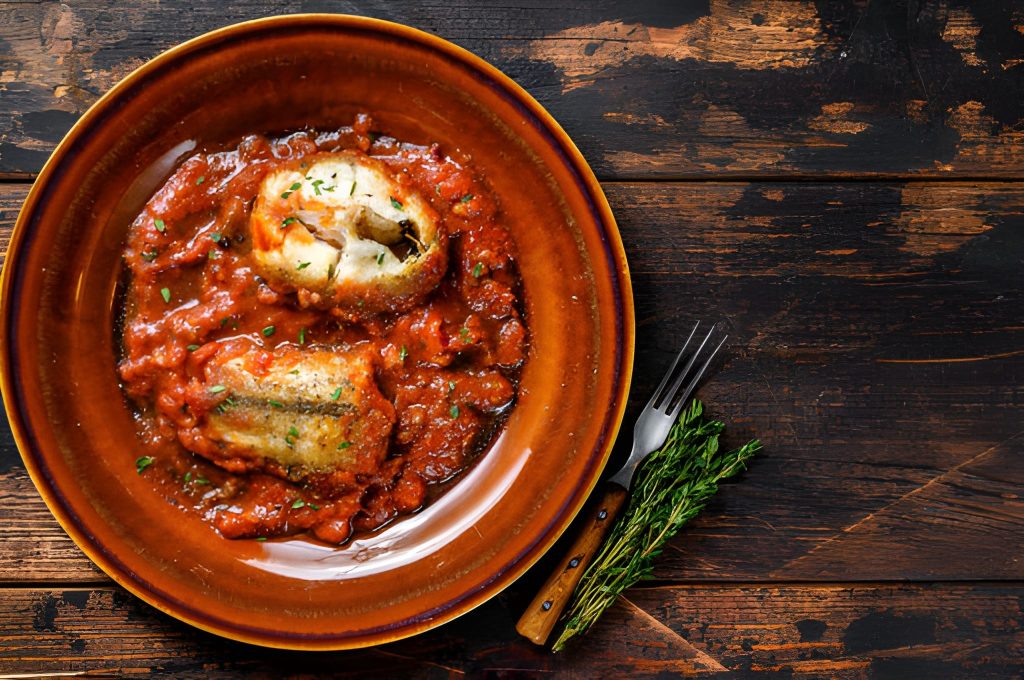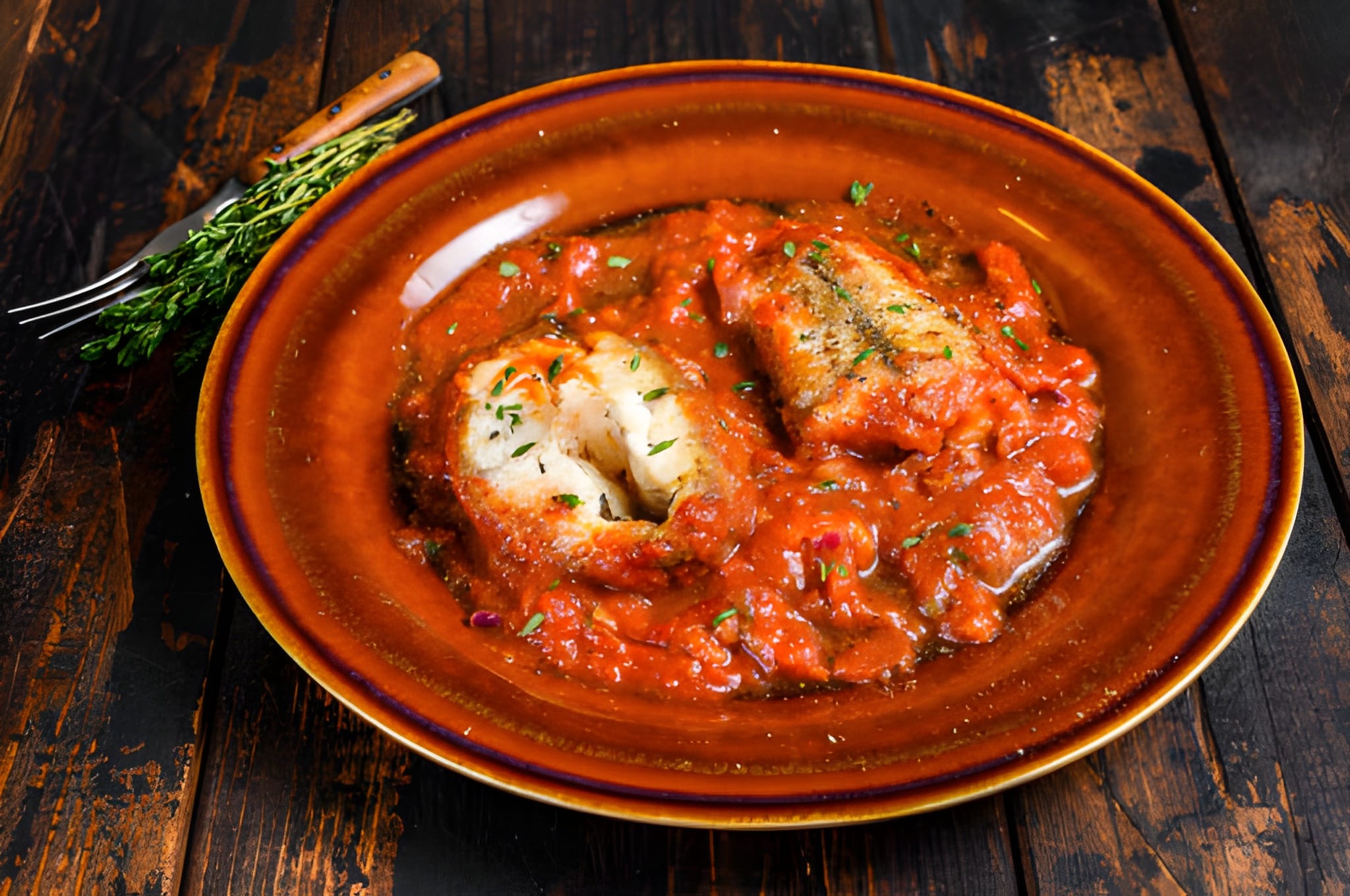White Fish in Tomato Sauce Recipe
A vibrant Mediterranean-style dish that brings together tender white fish fillets and a robust tomato sauce infused with garlic, herbs, and a touch of balsamic sweetness. This recipe strikes the perfect balance between simplicity and sophistication, making it ideal for both relaxed family dinners and elegant weeknight meals.

Ingredient Breakdown
The foundation of this dish lies in the quality and freshness of its ingredients. Choosing the right fish is crucial — opt for firm, mild varieties like cod, haddock, tilapia, or halibut, which absorb the sauce beautifully without falling apart. The onion, bell pepper, and garlic form the aromatic trio that infuses the sauce with depth and a subtle sweetness. When slowly sautéed, they develop a mellow flavor that enhances the acidity of the tomatoes.
Canned chopped tomatoes provide a reliable base, giving the sauce a vibrant red hue and a naturally rich body. Tomato paste deepens the color and intensifies the flavor, while a small amount of sugar balances the acidity. The addition of balsamic vinegar lends a faint tang and a layer of complexity, harmonizing the sweetness and acidity. A finishing sprinkle of fresh parsley introduces a refreshing herbal note that brightens the entire dish.
Step-by-Step Cooking Guide
Begin by chopping the onion and bell pepper into uniform pieces to ensure even cooking. Mincing the garlic finely allows it to release its full aroma without overpowering the dish. Heating the oil over medium heat sets the stage for the vegetables to soften gently — this slow sautéing process coaxes out their natural sweetness while preventing them from burning.
Once the vegetables have softened, garlic joins the mix, its fragrance blooming almost instantly. The tomato paste is stirred in next, allowing it to caramelize slightly and bring depth to the sauce. Pour in the chopped tomatoes with their juices, followed by sugar, salt, and pepper, blending everything together into a silky base.
As the sauce simmers, the flavors meld into a luscious, velvety consistency. The key is patience — letting the sauce cook slowly thickens it naturally while developing a deep, savory aroma. A drizzle of balsamic vinegar at the end sharpens the flavor and balances the sweetness.
Finally, the white fish fillets are gently nestled into the sauce. A few spoonfuls of sauce over the top help them cook evenly. Within minutes, the fillets turn opaque and begin to flake easily, signaling that they are perfectly done. Sprinkle fresh parsley over the top, and the dish is ready to serve — fragrant, vibrant, and full of coastal charm.

Recipe Tips & Frequently Asked Questions
Choosing the right type of white fish for ideal texture and flavor:
Use firm fillets like cod or haddock that hold together during simmering. Avoid overly delicate fish that might break apart.
How to prevent overcooking the fish while keeping it flaky and moist:
Simmer the fillets on low heat and remove them as soon as they flake with gentle pressure. Overcooking can make them dry and tough.
Tips for thickening or thinning the tomato sauce to your liking:
For a thicker sauce, let it simmer uncovered longer. If it becomes too thick, stir in a few tablespoons of broth or water.
Seasoning adjustments to complement different types of fish:
Delicate fish benefit from a lighter hand with herbs, while stronger varieties can handle extra garlic, chili flakes, or oregano.
Storing and reheating leftovers without drying out the fish:
Store in an airtight container for up to 2 days. Reheat gently on low heat with a splash of water or broth to preserve moisture.
Can I use frozen fish fillets instead of fresh ones?
Yes, just thaw completely and pat dry to prevent excess water from thinning the sauce.
What’s the best way to keep the sauce from becoming too acidic?
Add a pinch more sugar or a bit of cream to balance acidity naturally.
Can I substitute balsamic vinegar with another type?
Red wine vinegar or lemon juice can be used for a different but equally pleasant tang.
How can I make this dish spicier or more robust in flavor?
Add crushed chili flakes, smoked paprika, or even a pinch of cayenne for gentle heat.
Is it possible to make the sauce ahead of time?
Absolutely. The sauce can be made a day in advance and reheated before adding the fish for quick preparation.
What to Serve With This Recipe
This dish pairs beautifully with creamy mashed potatoes that absorb the tomato sauce’s vibrant flavor. Steamed white rice or fluffy couscous make wonderful alternatives for a lighter pairing. For something heartier, polenta or roasted potatoes complement the sauce’s savory richness. A side of lemon-dressed salad or grilled asparagus adds brightness and contrast, keeping the meal balanced. For beverages, a crisp Sauvignon Blanc or a dry Pinot Grigio accentuates the fresh, herbal notes, while sparkling water with mint or citrus makes a refreshing non-alcoholic choice.
Creative Variations
This versatile recipe welcomes countless adaptations. Add sliced olives, briny capers, or chili flakes for a Mediterranean flair. For a comforting baked version, top the fish and sauce with breadcrumbs and cheese, then bake until golden and bubbling. Swap the fish for shrimp, calamari, or even tofu to create a new twist on the same flavorful base. Leftovers can also be repurposed — toss the sauce with pasta or spoon it over cooked grains for a quick, nourishing meal the next day.
White Fish in Tomato Sauce is a timeless dish that showcases the simplicity of Mediterranean cooking — fresh ingredients, bold flavors, and effortless elegance. Every bite blends tender fish with a tangy, aromatic sauce that tastes as if it simmered all afternoon. Whether served on a quiet evening at home or as part of a family gathering, this recipe brings warmth, flavor, and comfort to the table.

Ingredients
2 cans chopped tomatoes (400 g / 14 oz each)
4 white fish fillets (125–140 g / 4.5–5 oz each)
1 medium onion (about 100 g / 3.5 oz)
1 green bell pepper, diced
3 large garlic cloves, finely chopped
2 tablespoons tomato paste
2 tablespoons oil
1 teaspoon sugar
½ teaspoon fine sea salt
¼ teaspoon freshly ground black pepper
½ teaspoon balsamic vinegar (up to 1 teaspoon, to taste)
2 tablespoons fresh parsley, chopped
Instructions
Finely dice the onion and mince the garlic cloves. Cut the green bell pepper into small, even cubes for uniform cooking.
In a large skillet or wide pan, heat the oil over medium heat. Add the onions and bell peppers with a pinch of salt and sauté for about 10 minutes, stirring occasionally, until softened and slightly golden. If the onions begin to stick, add a splash of water to help them cook evenly. Stir in the minced garlic and cook for another minute until aromatic.
Add the chopped tomatoes along with their juices, followed by the tomato paste, sugar, salt, and black pepper. Stir to combine, ensuring the ingredients are well blended. Reduce the heat slightly and allow the sauce to simmer gently for about 20 minutes, stirring occasionally, until the vegetables are tender and the sauce thickens. Taste and balance the flavor with balsamic vinegar, adjusting the salt and pepper if needed.
Once the sauce has developed a rich consistency, nestle the white fish fillets into the pan, spooning a bit of the tomato sauce over each piece. Let the fish simmer uncovered over low heat for about 5–7 minutes, depending on the thickness of the fillets. The fish should flake easily with a fork when perfectly cooked — tender and juicy but not overdone.
Remove the pan from the heat, sprinkle freshly chopped parsley over the top, and serve immediately. This flavorful dish pairs beautifully with creamy mashed potatoes, rice, or a side of crusty bread to soak up the vibrant tomato sauce.

White Fish in Tomato Sauce Recipe
Ingredients
- 2 cans chopped tomatoes 400 g / 14 oz each
- 4 white fish fillets 125–140 g / 4.5–5 oz each
- 1 medium onion about 100 g / 3.5 oz
- 1 green bell pepper diced
- 3 large garlic cloves finely chopped
- 2 tablespoons tomato paste
- 2 tablespoons oil
- 1 teaspoon sugar
- ½ teaspoon fine sea salt
- ¼ teaspoon freshly ground black pepper
- ½ teaspoon balsamic vinegar up to 1 teaspoon, to taste
- 2 tablespoons fresh parsley chopped
Instructions
- Finely dice the onion and mince the garlic cloves. Cut the green bell pepper into small, even cubes for uniform cooking.
- In a large skillet or wide pan, heat the oil over medium heat. Add the onions and bell peppers with a pinch of salt and sauté for about 10 minutes, stirring occasionally, until softened and slightly golden. If the onions begin to stick, add a splash of water to help them cook evenly. Stir in the minced garlic and cook for another minute until aromatic.
- Add the chopped tomatoes along with their juices, followed by the tomato paste, sugar, salt, and black pepper. Stir to combine, ensuring the ingredients are well blended. Reduce the heat slightly and allow the sauce to simmer gently for about 20 minutes, stirring occasionally, until the vegetables are tender and the sauce thickens. Taste and balance the flavor with balsamic vinegar, adjusting the salt and pepper if needed.
- Once the sauce has developed a rich consistency, nestle the white fish fillets into the pan, spooning a bit of the tomato sauce over each piece. Let the fish simmer uncovered over low heat for about 5–7 minutes, depending on the thickness of the fillets. The fish should flake easily with a fork when perfectly cooked — tender and juicy but not overdone.
- Remove the pan from the heat, sprinkle freshly chopped parsley over the top, and serve immediately. This flavorful dish pairs beautifully with creamy mashed potatoes, rice, or a side of crusty bread to soak up the vibrant tomato sauce.
Notes
- White fish options include pollock, cod, sea bass, hake, sole, halibut, tilapia, flounder, or pangasius — all of which work beautifully in this dish. As long as the fillets aren’t too thick, the cooking time remains fairly consistent.
- Fresh fish delivers a delicate flavor and texture, but frozen fillets are equally suitable for this recipe, especially since the fish is gently simmered rather than seared. To prevent excess moisture, thaw the fish completely and pat it dry between paper towels for about 15 minutes before cooking.
- Thicker cuts, such as the center portions of cod, may require a few additional minutes to cook through. The thickness of the fillets, more than their width, determines the ideal cooking time.
- It’s always better to err on the side of slightly undercooking the fish — it will continue to cook from residual heat after being removed from the pan. Overcooking can make the flesh tough and dry, so monitor closely and serve as soon as it flakes easily with a fork.

